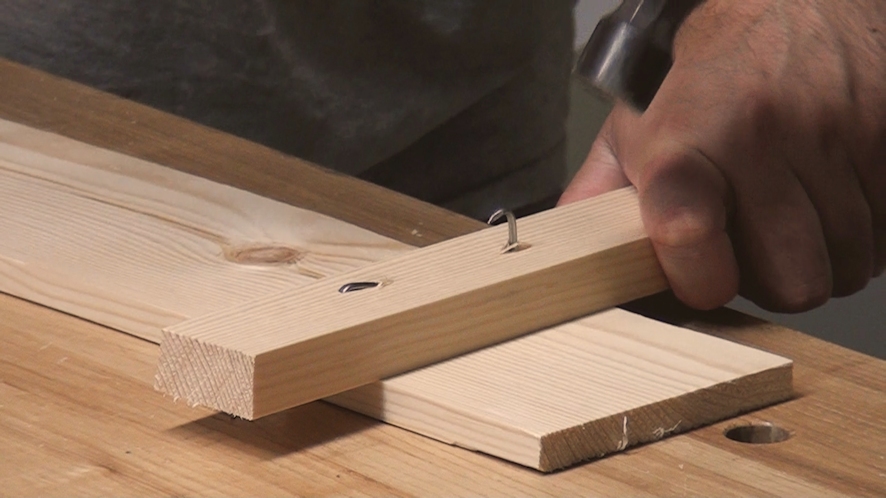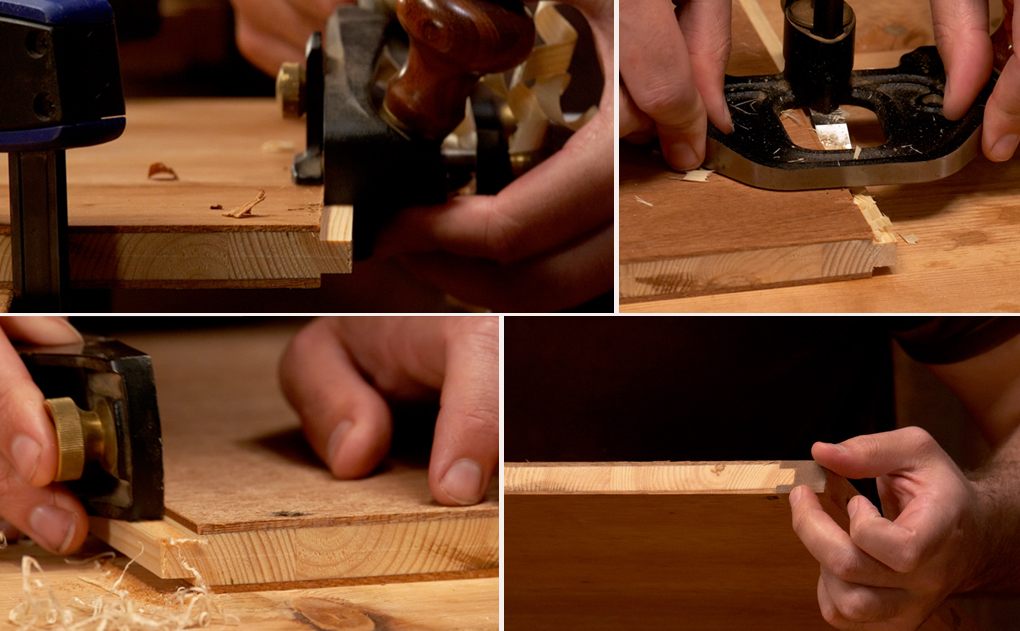Before publishing the final video in our Wall Cupboard series we’ll be bringing you a quick video next week which takes a look at clenching nails (or clinching; as it’s known round my parts).
I’ve recently written about the benefits that I feel draw boring can bring to today’s workshops and I find that clinching is another one of those old techniques which can easily get dismissed as irrelevant and redundant. Glues and screws have taken over the role since they’re strong and quick to use and so the most obvious reason to step back and do it the old way is to add character. I much prefer to have a practical reason behind my choices though and so along with demonstrating my simple method for clinching I’ll be using the video to explain which situations I feel it can still bring advantages over modern fixings.
Watching a chap bend over a nail could make for a fairly boring video so I’ll also be building a simple little project throughout it. On completing this you should have mastered clinching and be well prepared for building that door on the cupboard. It’s a dead easy project which could have a lot of uses around the workshop.
Learn how to Clinch Nails in Our Video


![Which Saws Are Best For Ripping Thick Stuff? [Video]](https://www.theenglishwoodworker.com/wp-content/uploads/2022/12/what-hand-saw-is-best-for-thick-rip-cuts.jpg)
![How do I Sharpen a Router Plane? [Q & A Video]](https://www.theenglishwoodworker.com/wp-content/uploads/2022/11/how-to-sharpen-a-router-plane-video.jpg)
![Bench Top Edge Jointing [with Video]](https://www.theenglishwoodworker.com/wp-content/uploads/2022/10/bench-top-edge-jointing-video.jpg)

Thanks for this one Richard. I have been in a few clinches, now I finely have it nailed. 😉
Thanks Richard. I am loving your videos and blog. On the subject of nails, what type do you use? I’ve seen some advocating cut nails but these seem impossible to find in anything other than floorboard size. What do you recommend for clinching etc.?
In the US you can always get good cut nails from Tremont Nail. http://www.tremontnail.com/tremont-furniture.htm
They have many nails to choose from and the Clinch Rosehead nails are good for clinching. I don’t know where to get them overseas, but I am sure there are still some suppliers out there.
Hi Tom,
Good cut nails are hard to come by in England now, I have some pretty good reserves which I’ve bought off Ebay but I am running pretty low. One of the last large makers in the UK has now moved to America believe it or not.
If you’re new to clinching then I’d definitely recommend using some oval nails which you can get from any builders merchants etc. These are brilliant if you’re new to it as they bend well in one direction and are what I’ve been using in the video.
Thanks Bill and Chris for those links.
Richard,
I’ve been searching for the “oval nails” you mentioned and I’m not able to find them. If you have a link, or different name (I could search for), please post a reply.
Another comment here had a link. And I found another via search (finally). I need to find out if they ship to the United States or not.
So far … their order forms do not accept my U.S. postal code so … it ain’t look’n good right now. 🙂
Hello Richard,
This ,seemingly uninteresting subject,can make,or break a project,there is nothing as bad as incorrect fixings on a project to totally ruin the effect. I have always saved the handmade nails from any strip down of ceilings etc,(I have buckets full of old nails) however,having been in oak beams for hundreds of years,they do need annealing,and straightening before use,I find it easier to buy new at
this company is in Ashford Kent.
Chris,
France.
The address did not come up on the screen!
http://www.anyoldiron.co.uk/PBSCCatalog.asp?ActionID=67174912&PBCATID=1785857&PBCATName=Rose head nails
When I built my picket fence a couple years ago, I clenched every nail. Glad I did as the underlying treated wood was pretty wet. After drying and many wet dry cycles, every board is still tight, which wouldn’t have been the case if I’d just shot them on with my paslode. There is a functional advantage to clenching in some cases. Schwarz posted government study http://blog.lostartpress.com/2009/03/22/clinching-nails-sometimes-teeth/ that is a good read.
Thanks Jeremy, I’ll take a look at that. The fence sounds like a prime example where the little extra step of clinching really comes in.
We have plenty of cut nails on this side of the pond, but the only oval nails I can find are these – U.K. only. 🙁 http://www.wickes.co.uk/nails+screws/oval-nails/icat/novalnails/
If anyone knows of oval nails available in the New World, please let us know.